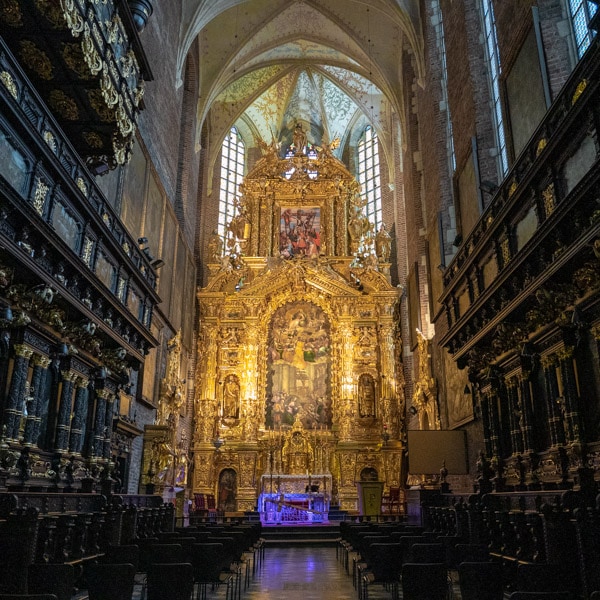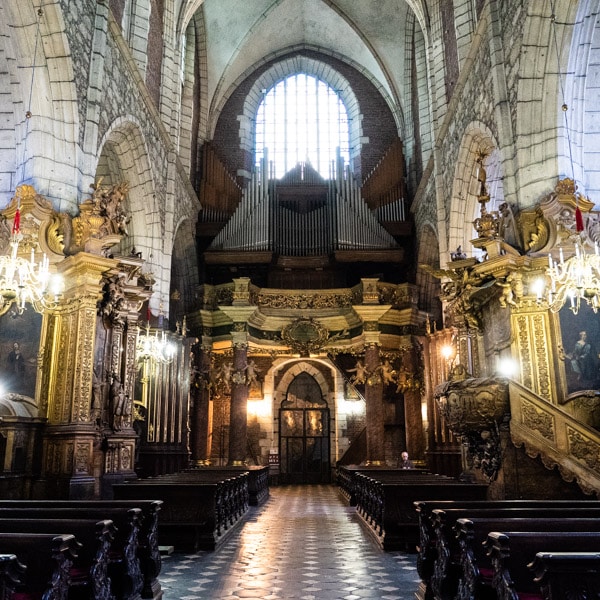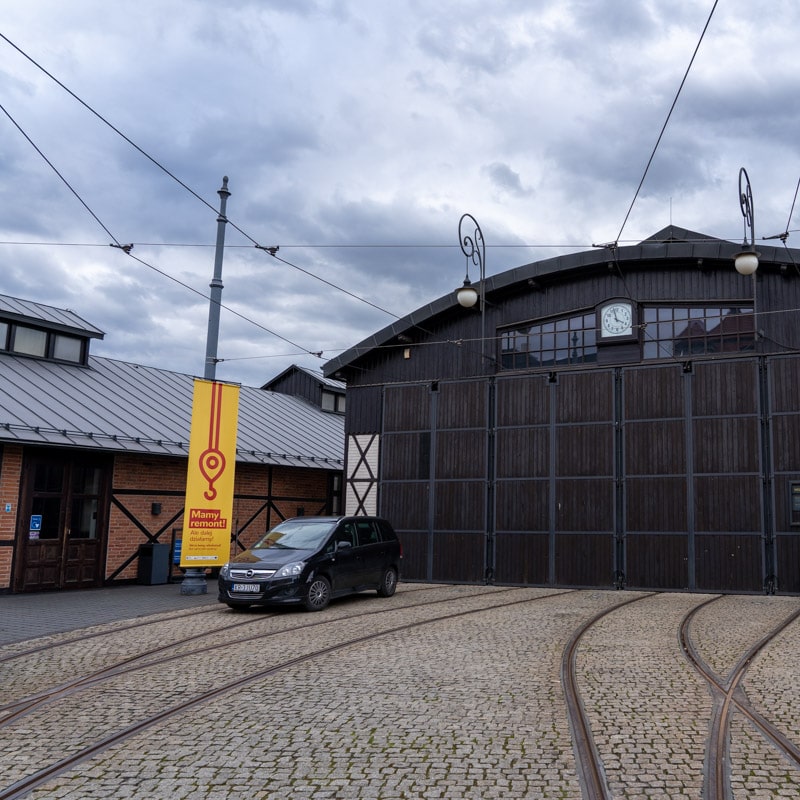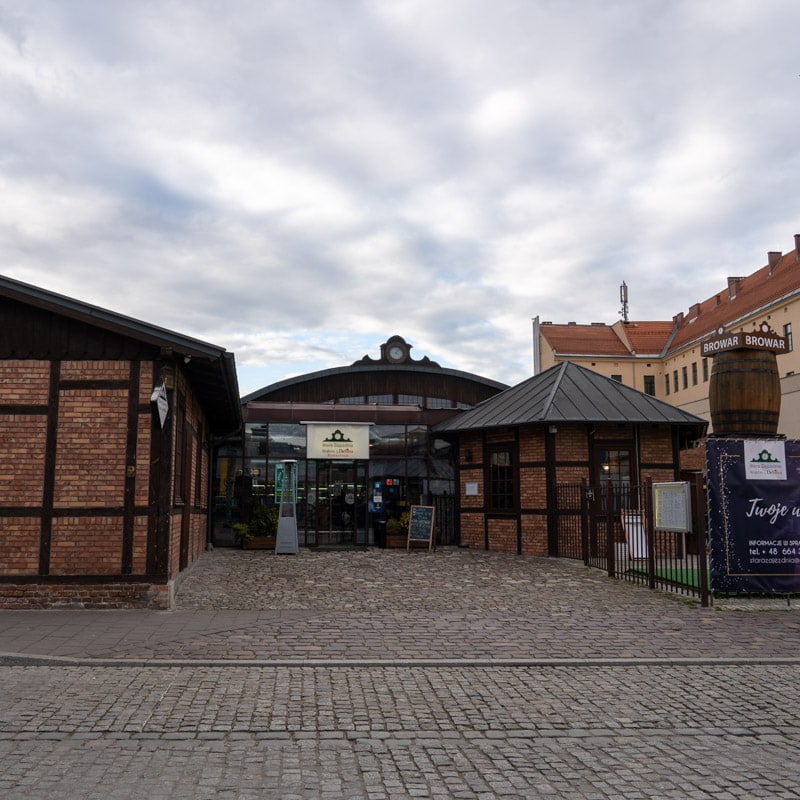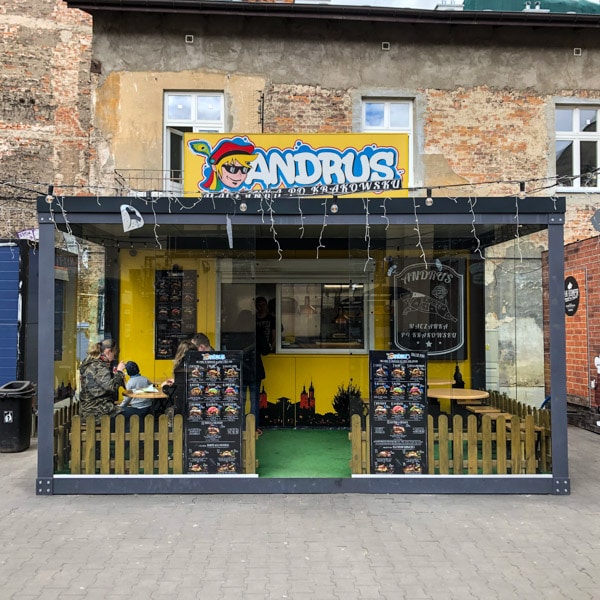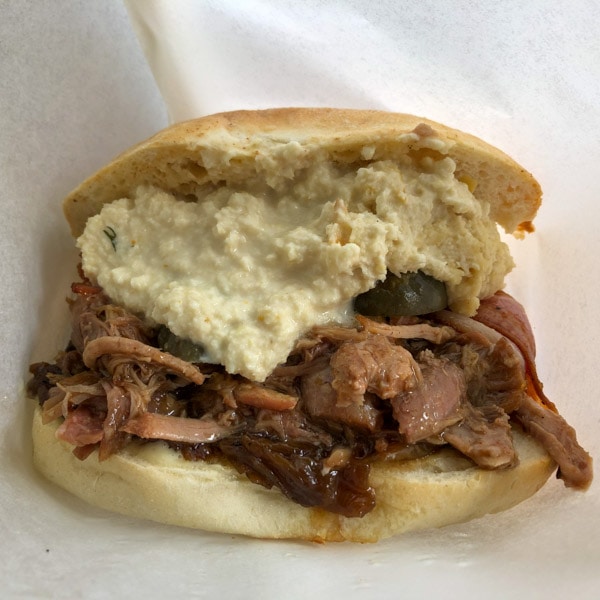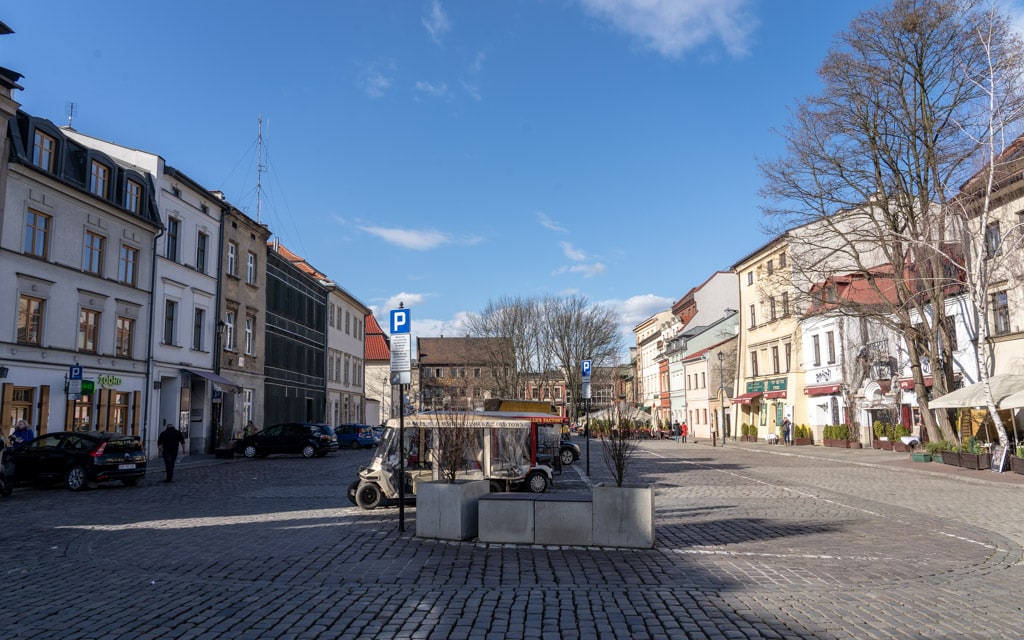
A short walk from the hustle and bustle of Old Town will bring you to Kazimierz, once the thriving historical Jewish district of Kraków. For centuries, Jewish and Polish cultures coexisted peacefully as many Jews relocated to the area and opened businesses, restaurants, and synagogues.
During World War II, much of Kazimierz was destroyed by the Nazis as Jews were sent to concentration camps, never to return. After the war, Kazimierz fell into disrepair.
At the end of the 20th century, new interest in the rich Jewish culture once located here led to the revitalization of the area.
Today, Kazimierz combines hipster culture, creative restaurants, food trucks, and edgy bars mixed with historic synagogues, cemeteries, and museums.
No visit to Poland is complete without a visit to Kraków. And no visit to Kraków is complete without a visit to Kazimierz.
Here is a list of 17 things to do in Kazimierz:
Table of Contents
1 – New Jewish Cemetery (Nowy Cmentarz)
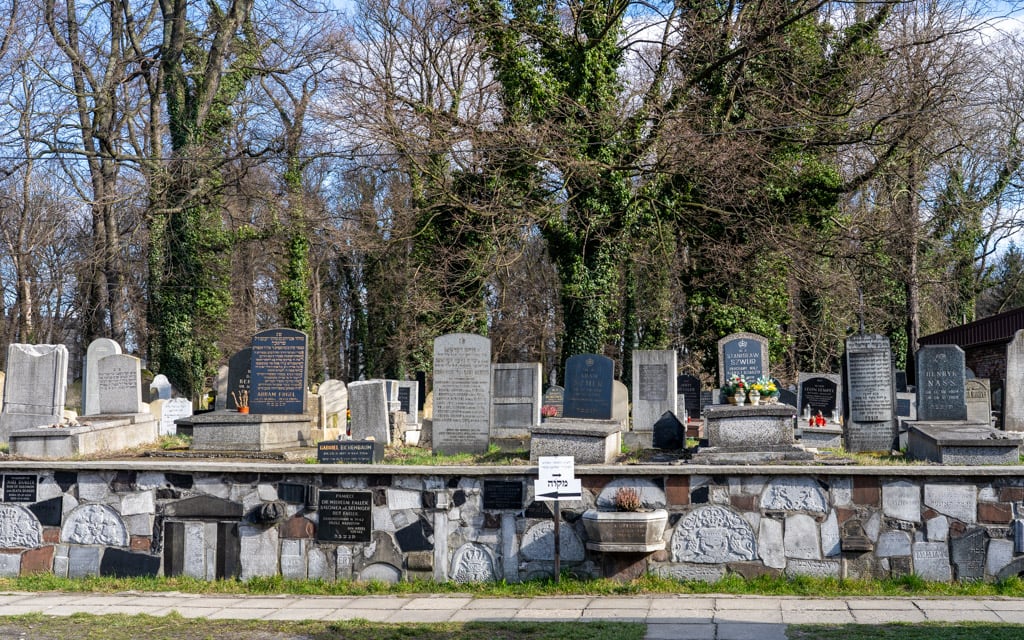
The New Jewish Cemetery (Nowy Cmentarz), established in 1800, is the burial ground of Kraków’s distinguished Jews. It contains the graves of those Jews of the 19th and 20th centuries.
During World War II, the Nazis vandalized the cemetery. They sold many of its finest tombstones to stone cutters and used others to construct concentration camp roads.
After the war, some recovered tombstones returned to their original sites. Workers used damaged tombstones to build the mosaic wall and Holocaust monument seen as you enter the cemetery.
Today, the cemetery holds an estimated 10,000 tombstones, ranging from simple to elaborate. The older graves use simple stones, while the modern graves are more elaborate and larger.
Many of the modern graves, with older dates, were put in here by relatives of the dead after the communist era. Written on these tombstones are one of four languages: Hebrew, Yiddish, Polish, and German.
2 – Szeroka Street (Ulica Szeroka)
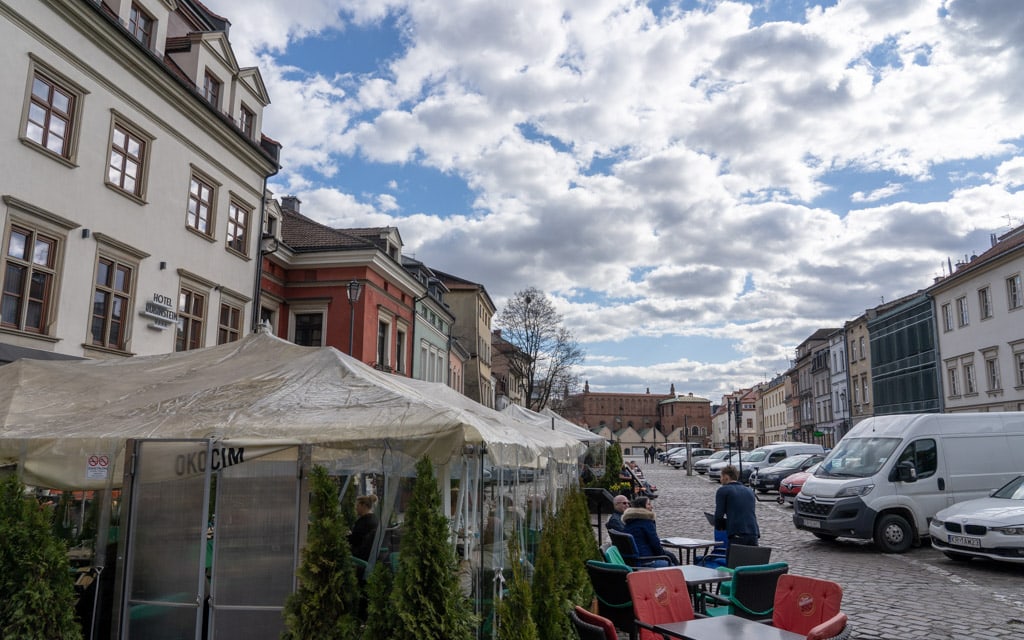
While Szeroka Street (Ulica Szeroka) looks more like a square, it’s an elongated street surrounded by Jewish-themed restaurants, hotels, museums, and synagogues. Locals and guides call this area “Broad Street,” the heart of Kazimierz.
In the 12th century, Ulica Szerok was the center of a small village known as Bawół. The village merged with Kazimierz in 1340.
Jews started relocating to Kazimierz in the 15th century after expulsion from Kraków. Over the years, Kazimierz became a thriving Jewish community.
Many important sights surround this street. Sights include the 15th-century Old Synagogue, the 16th-century Remuh Synagogue and Remuh Cemetery (Old Jewish Cemetery), and the 17th-century Popper Synagogue.
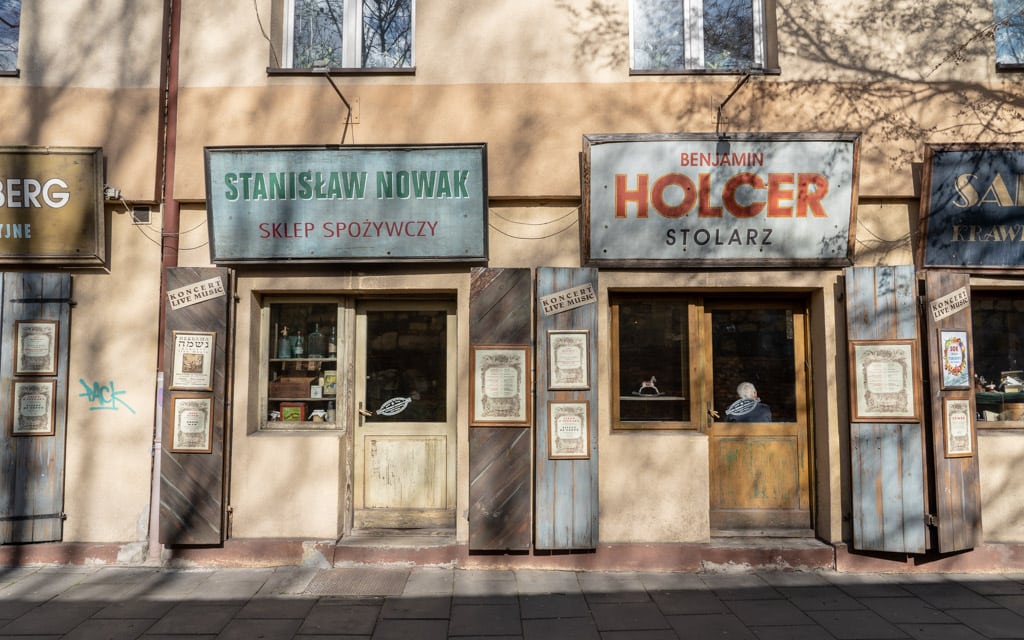
This street is also home to many traditional Jewish restaurants and cafes with outdoor tables. One is Hamsa Hummus & Happiness Restobar, a restaurant serving modern Israeli food at the square’s northern end.
A row of old, rustic Jewish shopfronts is just around the corner from the restaurant, leaving Ulica Szeroka to the north. These shopfronts, now restaurants, remind us of Kazimierz’s appearance before the Holocaust.
3 – Kazimierz Monument
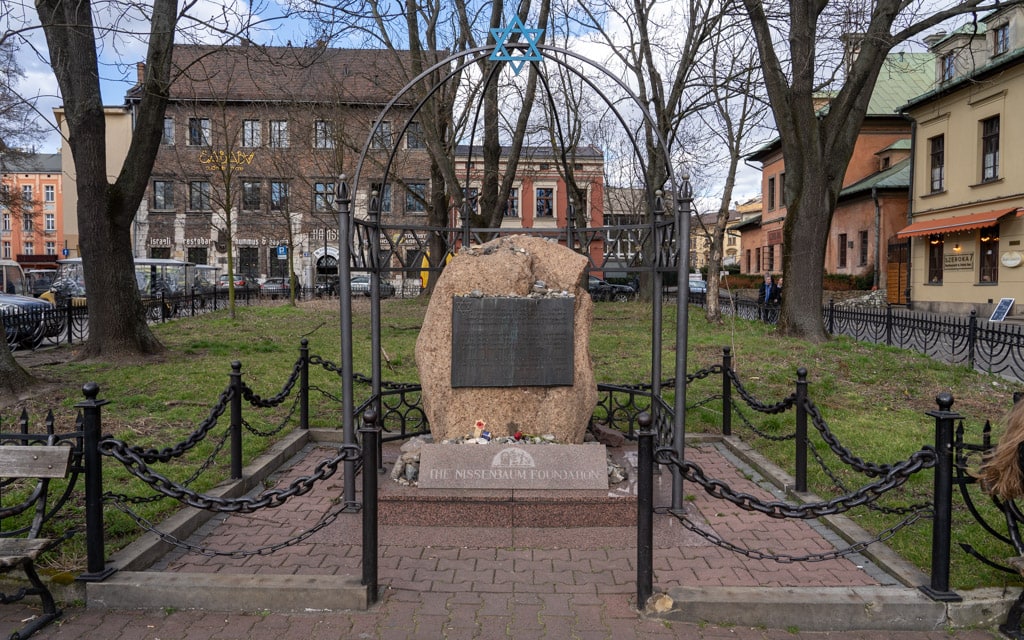
This small monument is the Kazimierz Monument. The memorial honors the 65,000 Polish citizens of Jewish nationality who resided in Kraków and surrounding areas during World War II. These citizens, murdered by the Nazis, made up more than a quarter of Kraków’s pre-war population.
When the Nazis arrived, they sent most of Kraków’s Jews to the ghetto of Lublin in eastern Poland. Those who remained were forced into the walled ghetto at Podgórze, just across the river to the southeast.
Many of the Jews’ buildings and cemeteries were ransacked, defiled, and destroyed. Around 1942, the Nazis sent Kraków’s Jews to concentration camps such as Auschwitz and Płaszów, not far from Kraków.
After the war in 1945, only a few thousand of Kraków’s Jews survived. This monument honors Kraków’s Jews before and after World War II.
4 – Remuh Cemetery (Old Jewish Cemetery)
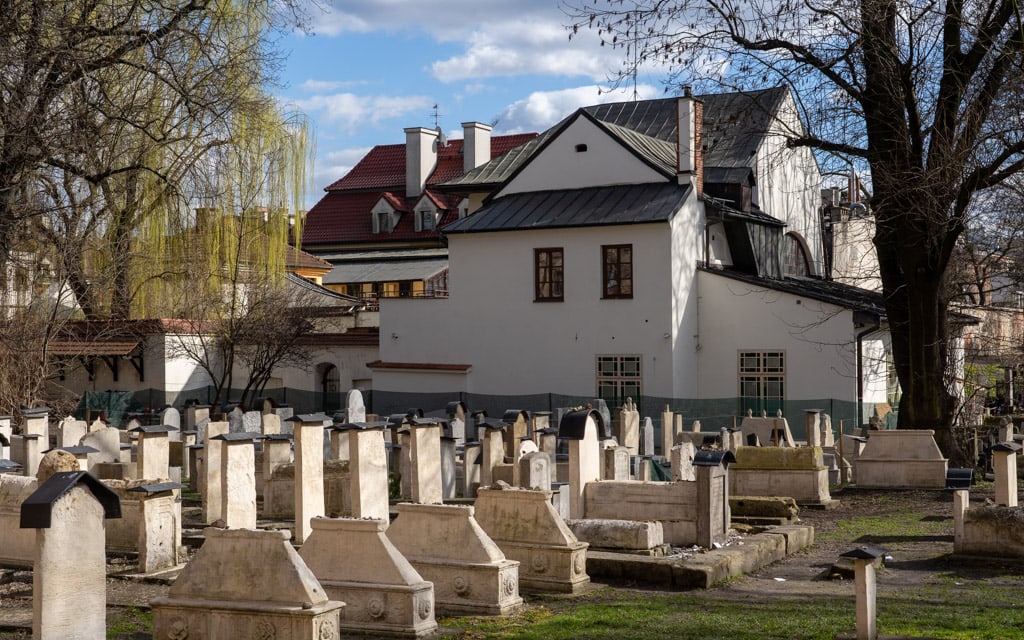
Established in 1553, the Remah Cemetery, also called Remuh Cemetery or the Old Jewish Cemetery of Kraków, is one of the most important and historic Jewish cemeteries in Europe.
The cemetery is the final resting spot of over 100 of Kraków’s influential Jewish intellectuals who lived between 1550 and 1800. In 1800, the larger New Jewish Cemetery (Nowy Cmentarz) replaced this cemetery.
In the 19th century, the cemetery fell into disrepair, and many stone cutters purchased tombstones. When the Nazis arrived, much of the cemetery, including most of its graves and tombs, were desecrated. They used many of the tombstones for roads at concentration camps.
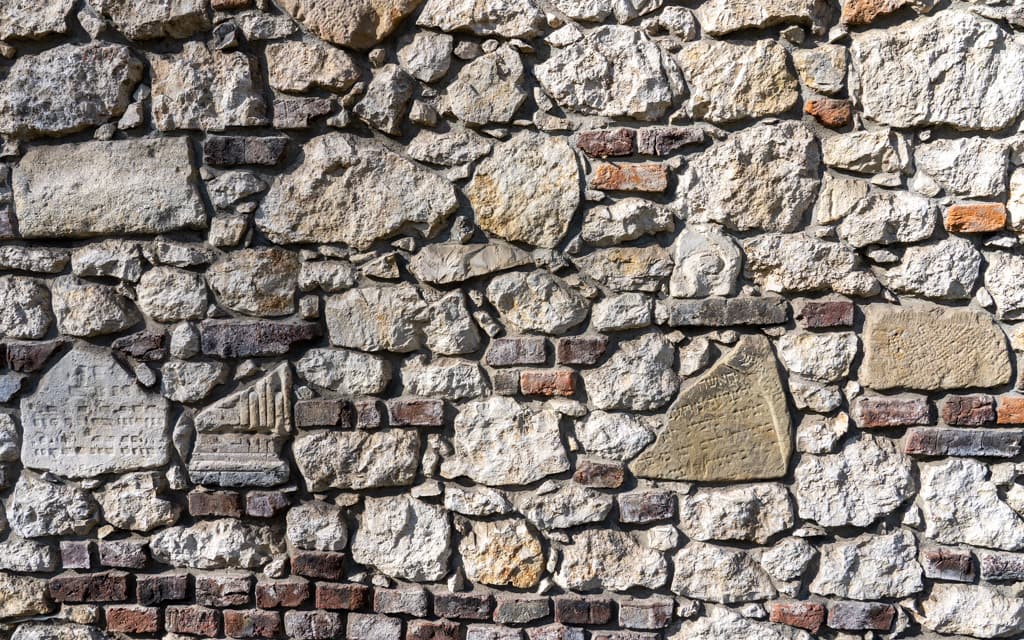
After the war, workers excavated and repaired the cemetery. Authorities recovered many of the stolen tombstones, although many suffered irreparable damage. Workers used these tombstones to form the mosaic wall that surrounds the cemetery.
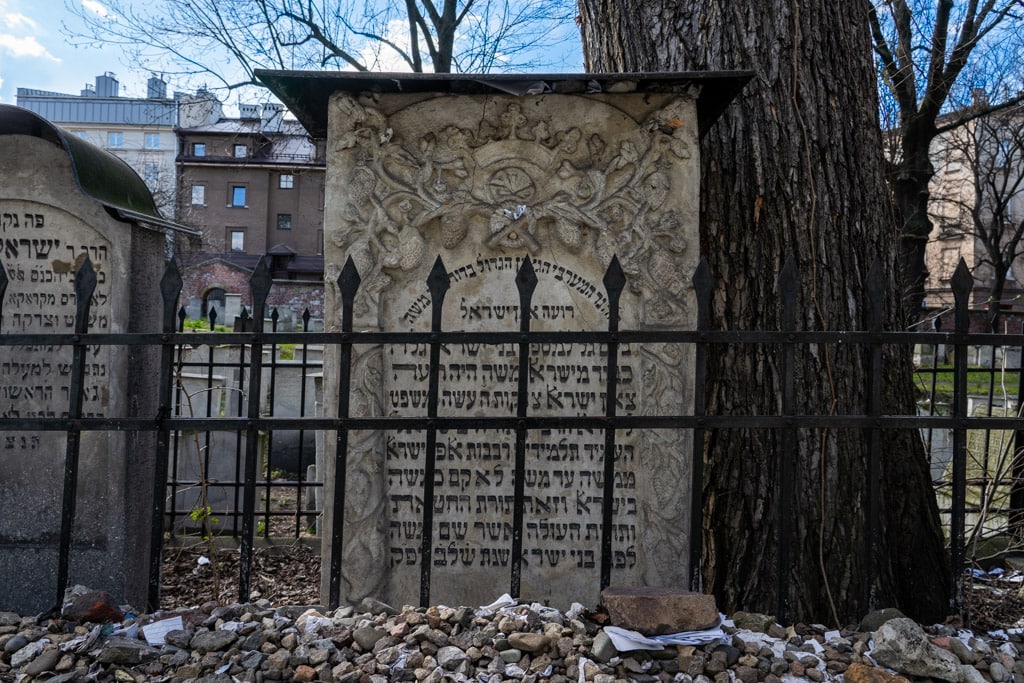
One of the only tombs to survive the destruction of World War II was the tombstone of Rabbi Moses Isserles. Isserles, born in Kraków in 1530, was a Polish Ashkenazic rabbi called Remah. The cemetery gets its name from him.
His tombstone is in the fenced area adjacent to the small white Remah Synagogue. Written prayer papers are crammed into his tombstone and on the ground in front.
Remuh Synagogue (Synagoga Remuh)
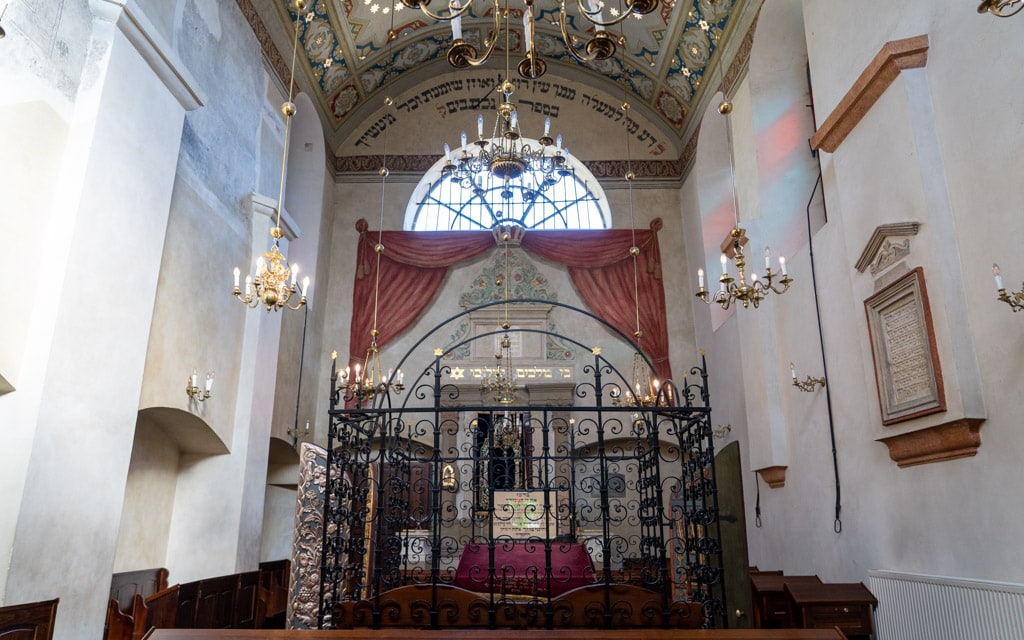
The Remuh Synagogue (Synagoga Remuh) is the smallest synagogue in the Kazimierz district. It is also one of only two active synagogues in all of Kraków.
Construction on the synagogue ended in 1557 at the edge of a newly built cemetery. The late Renaissance-style building was renovated and restored over the 17th, 18th, and 19th centuries.
Though much of what you see today dates back to a renovation in 1829, some elements of the original 16th-century synagogue remain. These include the painted limestone walls, a collection box near the door, and the Torah ark (aron kodesh) from 1558.
5 – Jan Karski Bench Statue
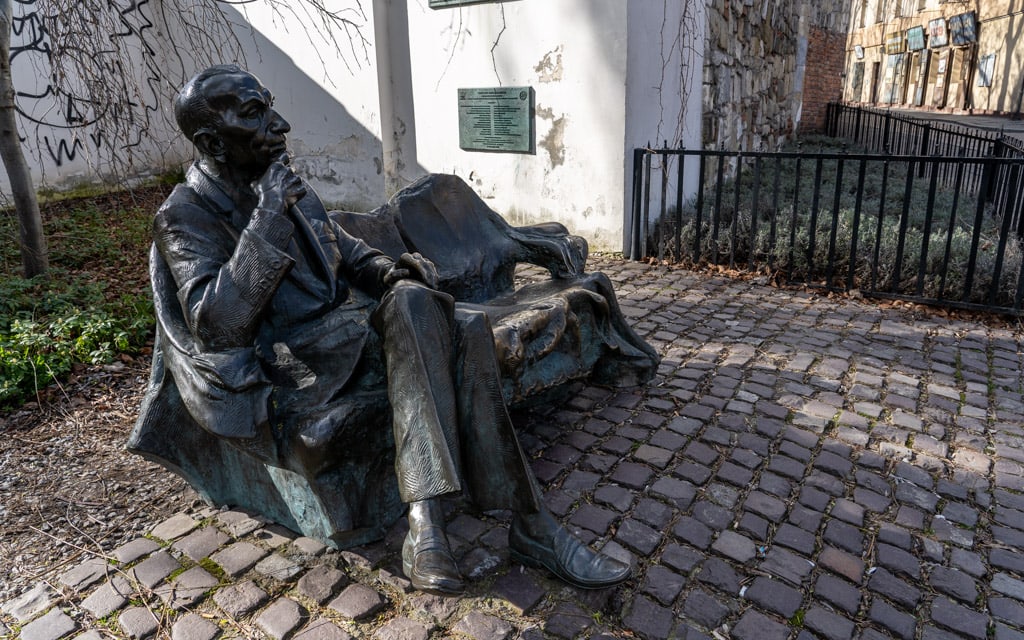
Just outside the entrance of the Remuh Cemetery is a bronze statue of a gentleman sitting on a bench. Installed in 2016, this is the Jan Karski Bench Statue.
Jan Karski (1914-2000), born Jan Kozielewski in Łódź, Poland, was a Polish resistance fighter and World War II whistle-blower.
During World War II, Karski performed secret missions and gathered intel of Nazi atrocities, including the destruction of the Warsaw Ghetto and the Holocaust in Poland. He would then report to the Polish Government-in-Exile, based in Paris, and Western Allies, including the British and U.S. governments.
Karski was one of the first eyewitnesses to present credible evidence to the world of the extermination of European Jews in Europe and German-occupied Poland.
Karski presented his report to multiple government and civic leaders, including President Franklin D. Roosevelt. Unfortunately, many of these leaders did not believe Karski’s story, which seemed unbelievable.
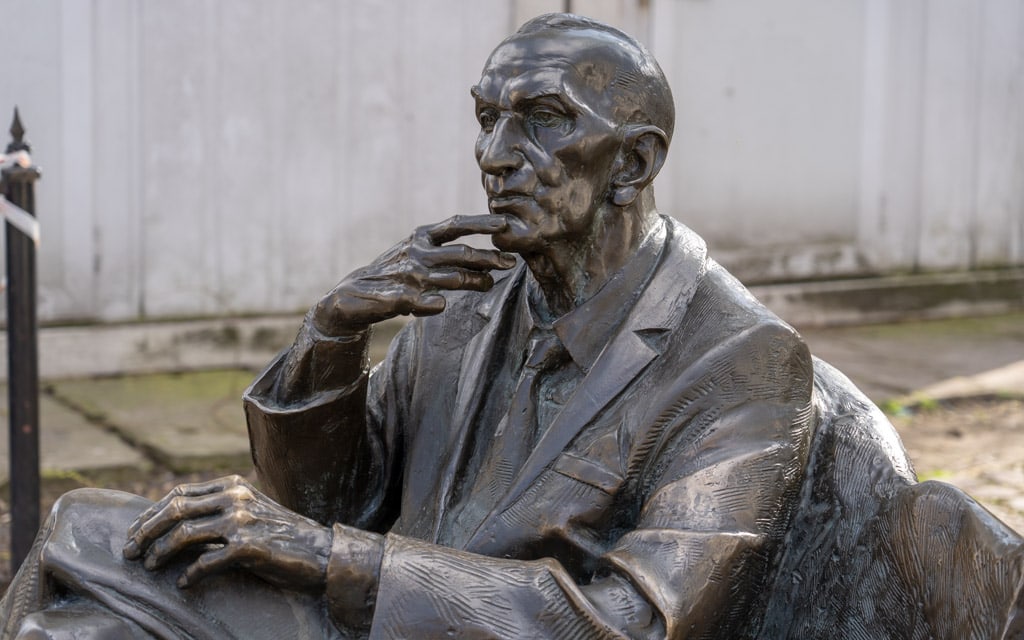
In 1944, Karski published a book titled Courier from Poland: The Story of a Secret State. In this book, Karski writes about his experiences and the horrors he encountered in Poland during World War II. By the war’s end, the book sold more than 400,000 copies.
After the war, Karski lived in the United States, where he taught at Georgetown University for 40 years.
6 – Wolf Popper Synagogue (Synagoga Poppera Bociana)
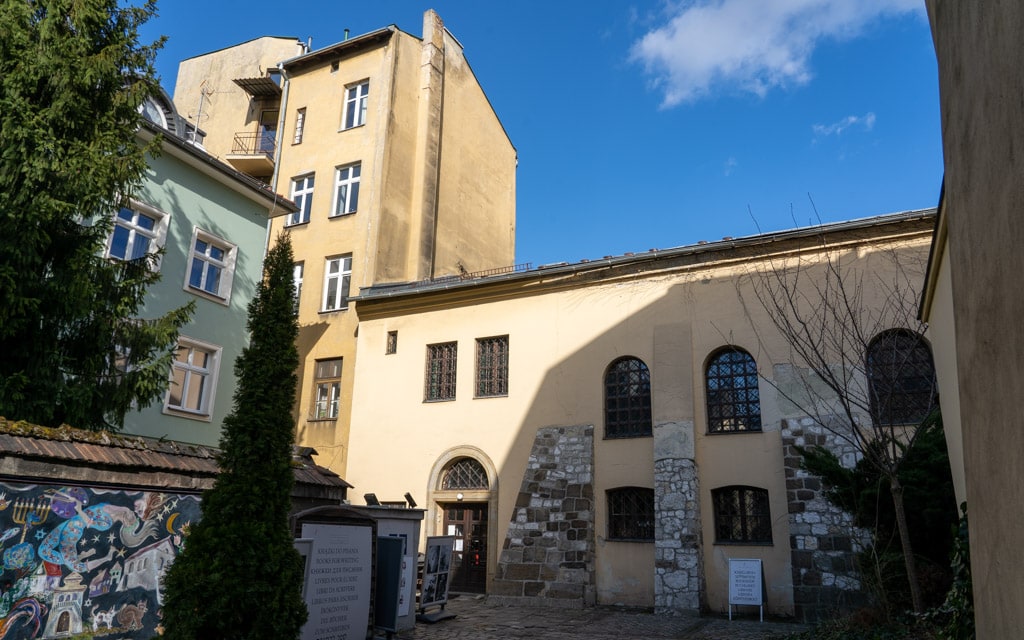
From Ulica Szeroka, pass through the gate into the inner courtyard of the Wolf Popper Synagogue (Synagoga Poppera Bociana).
When founded in 1620 by Wolf “The Stork” Popper, the synagogue was considered Kazimierz’s most beautiful house of worship. Popper used his wealth to design the synagogue and purchase rich furniture and decorations for its interior. After Popper’s death, the synagogue fell into disrepair.
During World War II, the Wolf Popper Synagogue, including its rich interior, was destroyed and gutted by the Nazis. After the war, the synagogue ceased functioning as a house of worship.
During the communist era, city officials handed the synagogue to the Old Town Youth Cultural Centre (YCC). Although its religious function ended, the synagogue now hosts educational activities related to Jewish history and culture.
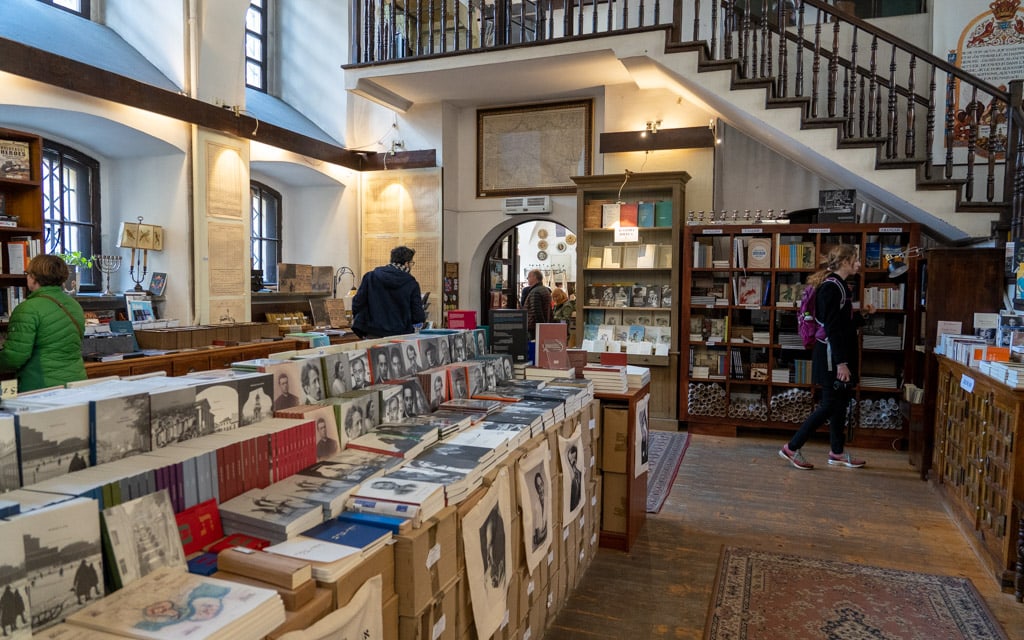
If you have time, be sure to step inside the beautiful interior of the old synagogue, where you will find an extensive bookstore and a small gallery.
7 – Old Synagogue (Stara Bożnica)
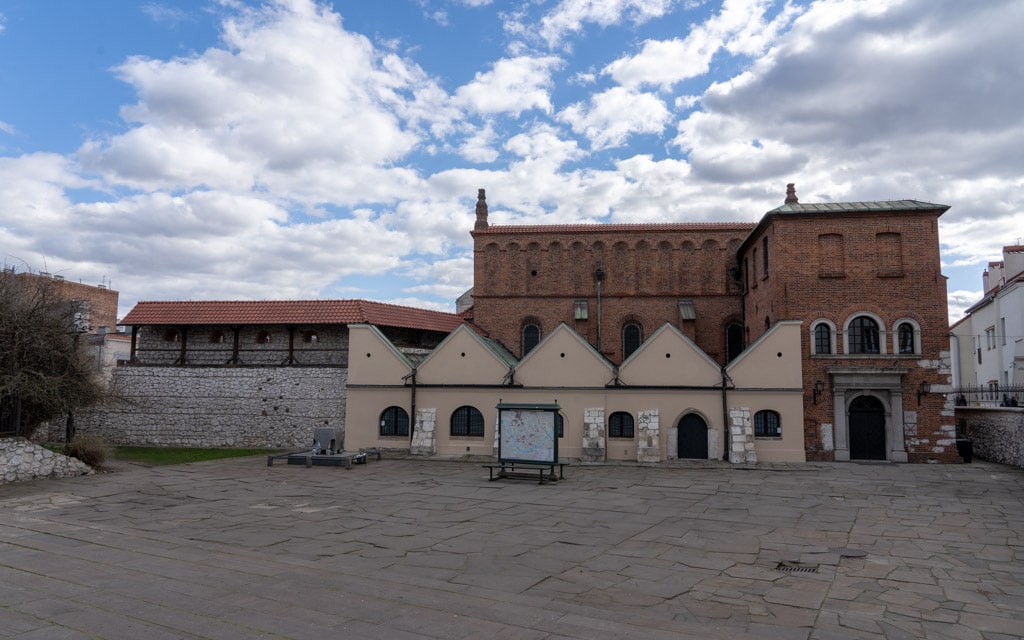
Dating back to the 15th century, the Old Synagogue (Stara Bożnica) is the oldest surviving synagogue in Poland. It is also an important landmark of Jewish architecture.
Until World War II, the Old Synagogue was the principal place of worship and the center of the Jewish community in Kraków.
You might have noticed that the synagogue is below street level. When built, Jewish structures were not allowed to be taller than Christian structures. Therefore, many Jewish structures sit below street level to ensure proper proportions.
In 1570, Polish-Italian Renaissance architect and sculptor Mateo Gucci supervised the rebuilding of the synagogue. Gucci borrowed ideas from military architecture during the reconstruction and added embrasures, or loopholes, to the attic.
The builders moved the windows from ground level to a higher position. Finally, they reinforced the masonry walls to withstand attacks. The synagogue is a rare example of a Polish fortress synagogue, built to withstand attacks and protect those inside.
Like many other Jewish structures in Kazimierz, the synagogue was ransacked and destroyed during World War II. Looters stole artwork and relics.
For the remainder of the war, the Nazis used the building as a warehouse. It was not until after the war that the synagogue’s renovation began.
Today, the Old Synagogue is not a working synagogue but an informative three-room museum. Displays show the history of Jewish culture in Kazimierz and Kraków. And don’t miss the well-preserved prayer hall.
8 – Modern Kazimierz
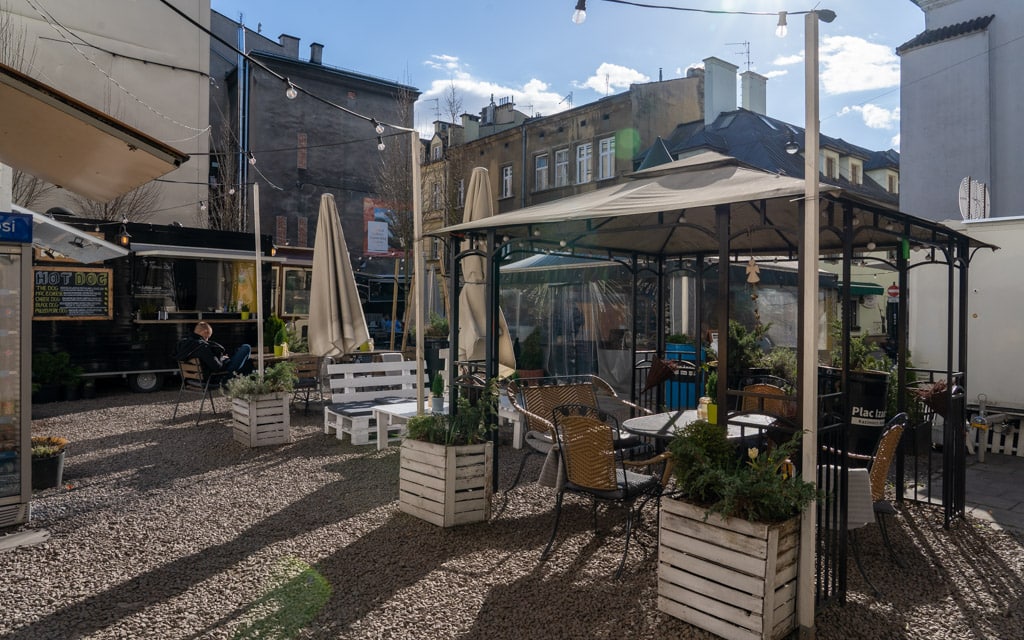
This pod of food trucks in the shadows of Isaak Synagogue is part of modern Kazimierz. Three food truck pods are scattered around Kazimierz, offering affordable yet delicious fast food.
If you’re hungry, check out the food trucks selling hot dogs, tacos, burgers, wraps, smoothies, ice cream, chimney cakes, and more.
By the end of World War II, Kazimierz was all but destroyed. With most of its citizens murdered during the Holocaust, this area fell into neglect. Things did not improve during the communist era when communist authorities ignored Jewish heritage.
In 1988, the Jewish Cultural Festival started its annual Jewish festival in Kazimierz. This festival sparked a new interest in Jewish culture. In 1993, Steven Spielberg filmed much of his film Schindler’s List in the area, drawing international attention.
The new interest in Kazimierz resulted in the revitalization of the area, including renovating historic sites and opening new businesses.
Today, Kazimierz is the center of youth culture in Kraków. You will find trendy restaurants, bars, shops, galleries, and food trucks here.
With its cheap rent, unique buildings, and central location, modern Kazimierz has become popular with creative young people, artists, entrepreneurs, and tourists.
9 – Isaak Jakubowicz Synagogue
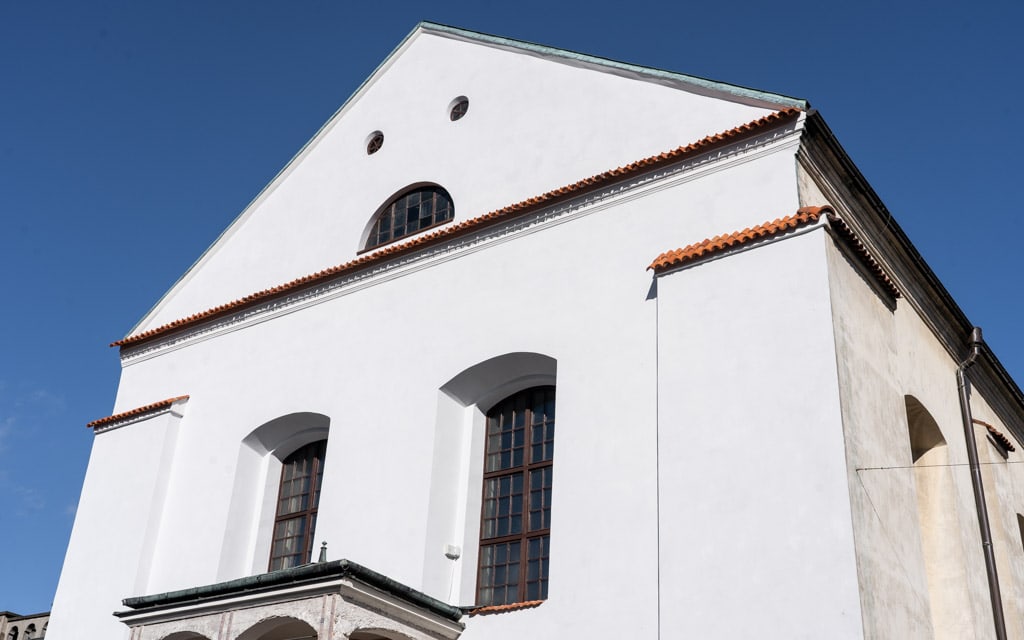
The 17th century Isaak Jakubowicz Synagogue, also known as Izaak Synagogue or Isaac Synagogue, is one of the largest synagogues in Kraków.
This early Baroque building, named after Izaak Jakubowicz, also known as Isaac the Rich, was a banker to King Władysław IV.
During World War II, the Nazis destroyed much of the synagogue, including furnishings such as the Baroque Torah ark (Aron Kodesh).
After the war, the building served different purposes, such as an art workshop, a theater, and storage space.
A fire damaged the building in 1981. After a renovation in 1983 and the fall of communism in 1989, the Jewish community converted the building back into a practicing Orthodox Synagogue.
Inside the synagogue, painted prayers adorn the walls of the prayer hall. Worshipers who could not afford to purchase prayer books used these prayers.
Many historians consider the Isaak Jakubowicz Synagogue the most beautiful and architecturally significant of Kraków’s synagogues.
10 – Plac Nowy
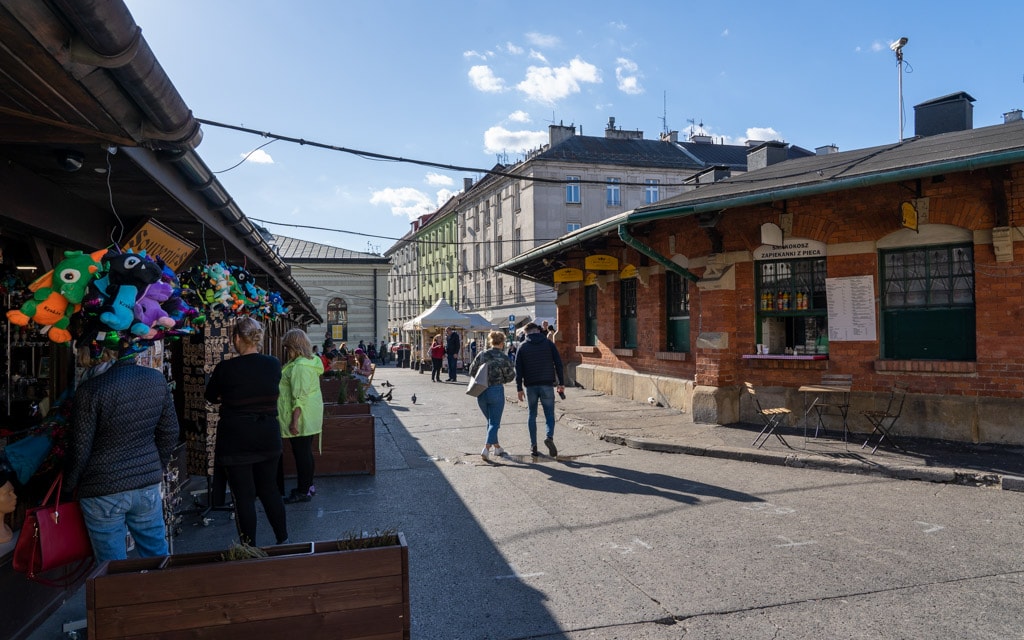
This square, known as Plac Nowy, is Kazimierz’s new square. Plac Nowy has retained its grittiness even with the threat of tourism and gentrification. If you are looking for something different than the Old Town charm, this is it.
In the late 17th century, the square, known as Plac Żydowski (Jewish Square), was incorporated into the Jewish Quarter.
It wasn’t until 1900 that construction began on the circular brick building in the center. This building, known as Okrąglak (Rotunda), was the slaughterhouse where Jewish butchers would process livestock such as chicken.
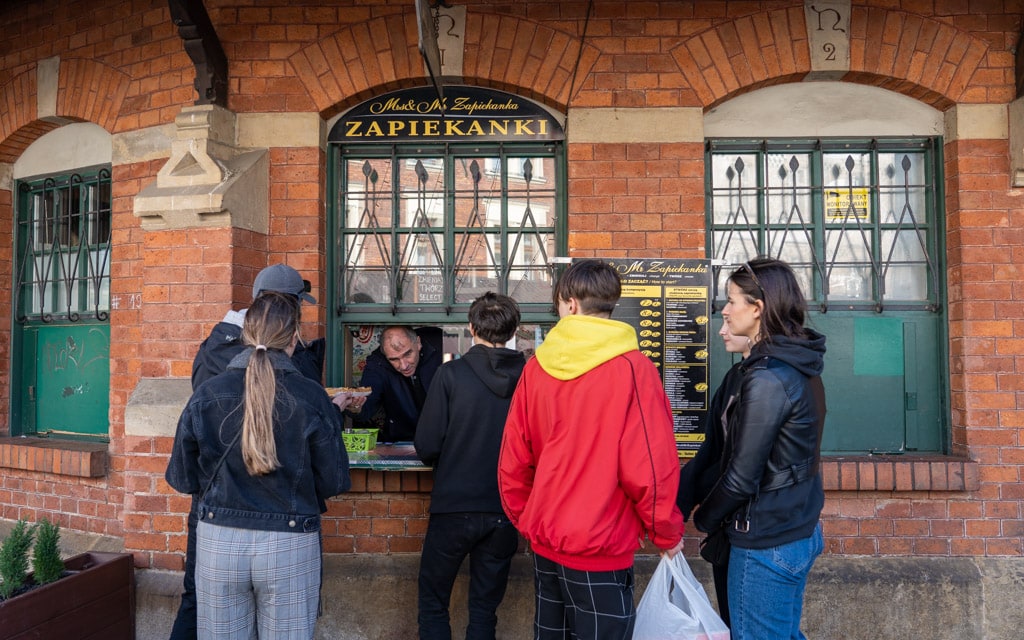
While butcher shops still occupy the interior of the building, hole-in-the-wall, stand-up eateries have taken over. These small shops, popular with locals, mainly sell zapiekanki, a Polish-style street food similar to a French bread pizza topped with various ingredients. You can’t leave Poland without trying zapiekanki.
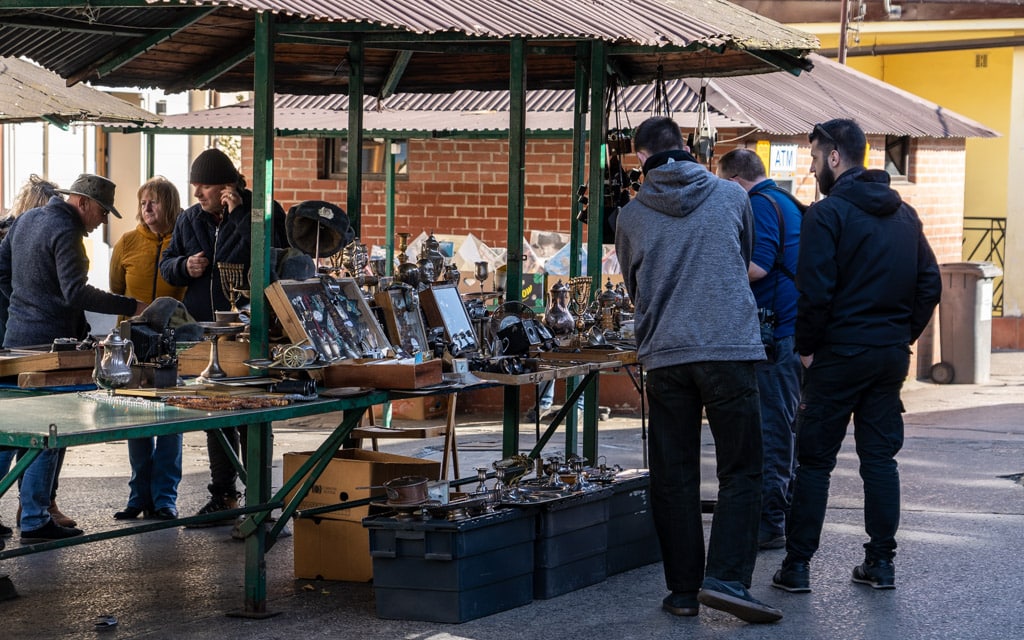
Surrounding the slaughterhouse are trading stalls selling various goods and crafts, including souvenirs, produce, and more food. Also nearby are several enjoyable craft beer bars and clubs.
11 – Plac Wolnica
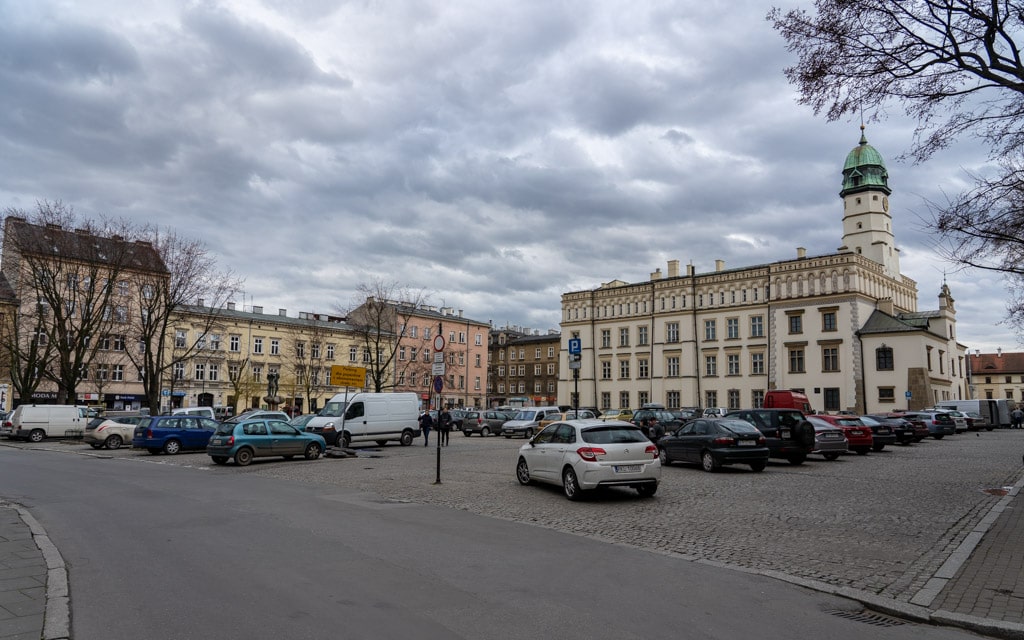
Known initially as Rynek Kazimierski, the square was renamed Plac Wolnica at the end of the 18th century. When Kazimierz was a separate town, this square served as its main square.
When established in 1335, Rynek Kazimierski was similar in size to Rynek Główny, making it the second-largest square in Poland.
Just as with Rynek Główny, Rynek Kazimierski featured a marketplace with hundreds of stalls, the Kazimierz town hall, administrative and judicial authorities, and a large church. This church is Corpus Christi Basilica (Bazylika Bożego Ciała).
Today, Plac Wolnica occupies only a tiny fraction of the square’s original footprint. After Kazimierz merged with Kraków in 1892, the square and town hall fell into disrepair.
Thankfully, local Jewish authorities took over the town hall and renovated it. Today, the neo-Renaissance style building houses the often overlooked Ethnographic Museum, a must-visit for lovers of Polish folk culture.
While urban revitalization has been slow to reach Plac Wolnica, many restaurants and cafes have opened up around the square and nearby streets. Unfortunately, since the summer of 2019, the square has been used as a car park.
12 – Schindler’s List Passage (Mrs. Dresner Courtyard and Stairs)
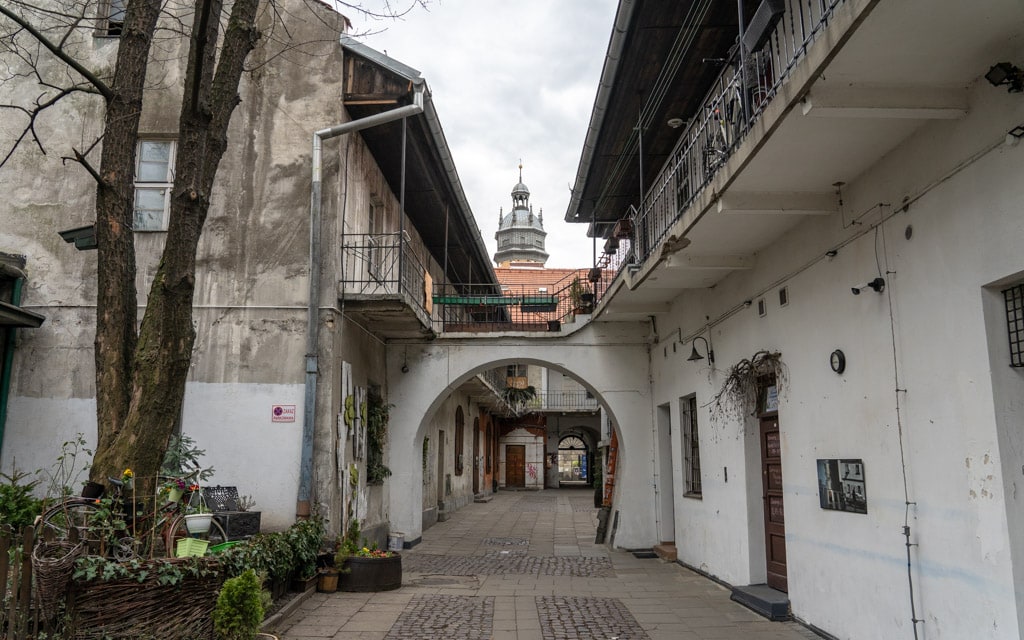
This peaceful courtyard, known as Schindler’s List Passage, is a popular tourist spot featured in a scene of Steven Spielberg’s 1993 film, Schindler’s List.
Portrayed in the movie is the final “liquidation” of the Podgórze ghetto. Between March 13th and 14th, 1943, the Nazis searched for and captured Jews who were hiding in the ghetto.
Those who were able to work went to concentration camps. Sadly, the Nazis murdered the Jews who tried to escape or who were unable to move for whatever reason.
One of the movie’s more memorable scenes took place in this courtyard. While the actual events occurred in nearby Podgórze, Spielberg decided to film in the Kazimierz district, an authentic Jewish quarter.
In the scene, Mrs. Dresner, the aunt of the little girl in red, hid underneath the staircase next to the arch to hide from the Nazis searching the area.
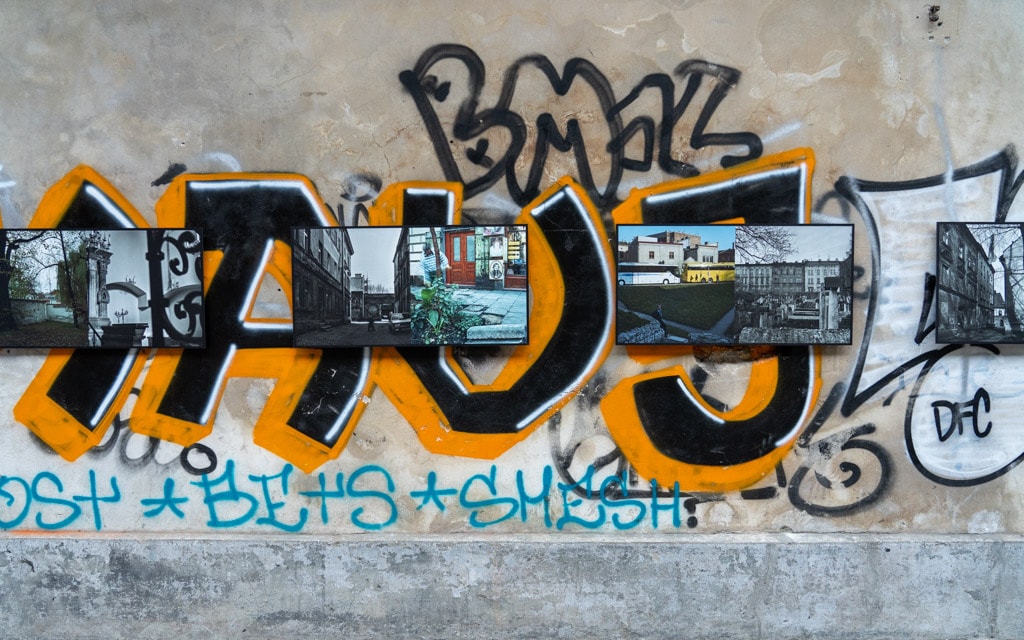
If you are interested in the courtyard’s history, look at the wall near the arch. Here, you can view black-and-white stills from the movie and historical courtyard photos.
13 – Ulica Meiselsa and Ulica Bożego Ciała
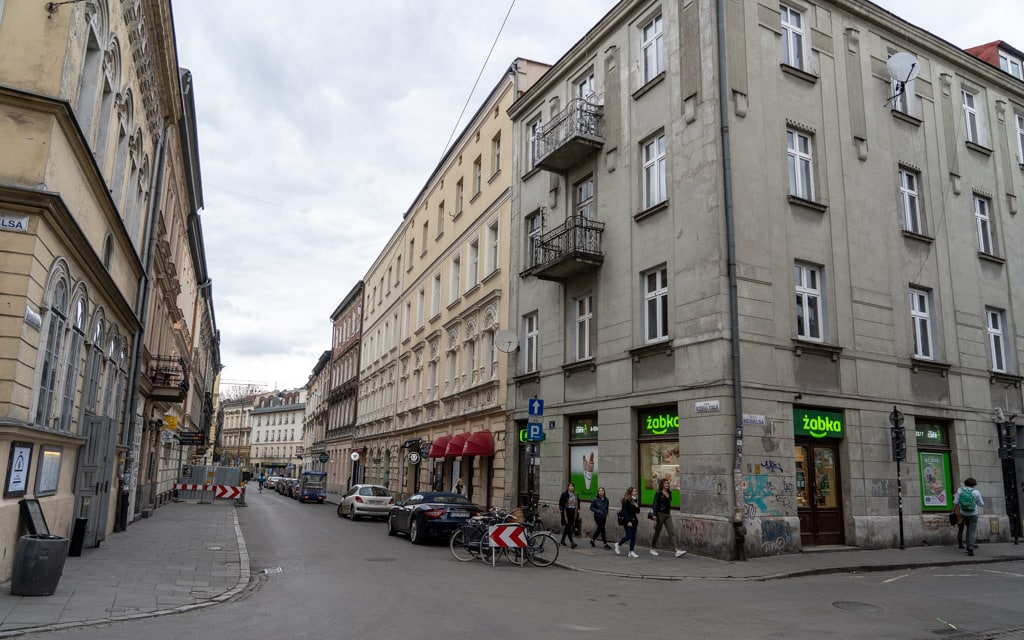
Before the Nazis arrived in World War II, Jews and Christians lived and worked in relative harmony in Kazimierz. Where you stand now is the intersection of Ulica Meiselsa and Ulica Bożego Ciała.
The names of these two streets intersect Judaism and Christianity. First, Ulica Meiselsa (Meiselsa Street), named after Dow Ber Meisels (1798-1870). He was the Chief Rabbi of Kraków from 1832 and the Chief Rabbi of Warsaw from 1856.
Second, Ulica Bożego Ciała (Corpus Christi Street), named after the towering red brick Corpus Christi Basilica (Bazylika Bożego Ciała) located nearby.
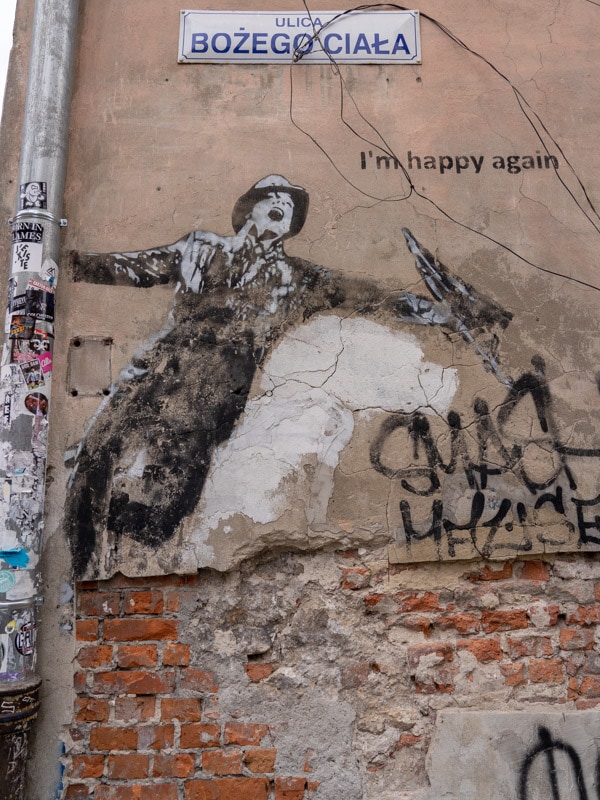
On the corner, with an umbrella in hand, a mural of Gene Kelly hangs off a drainage pipe. While the Holocaust was a dark time for Kazimierz, today, things are “happy again.”
Located in the area is Hevre, a bar and restaurant that was a Jewish bathhouse in the 19th century. Also nearby is Mleczarnia, a quirky and cozy spot with a fantastic beer garden.
14 – Corpus Christi Basilica (Bazylika Bożego Ciała)
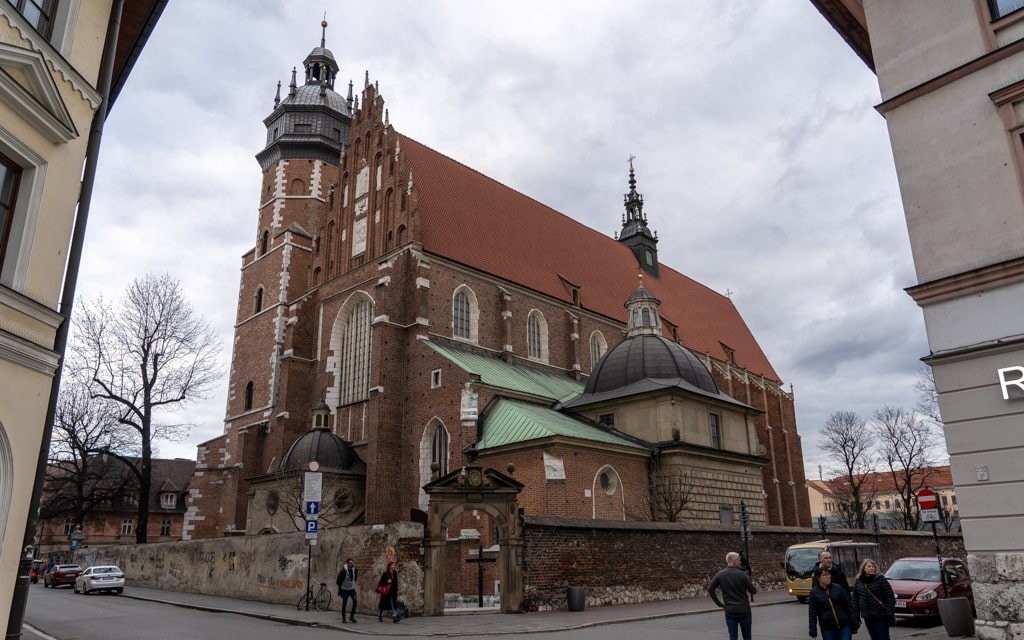
This massive red brick and stone church on the corner of Plac Nowy is Corpus Christi Basilica (Bazylika Bożego Ciała). The church is one of the largest in Kraków.
Founded in 1335 by Kazimierz the Great, Corpus Christi Basilica was built in stages over two centuries, from the 14th to the 16th centuries. It was originally built as a monastery, which explains its size.
In 1655, during the Second Northern War, soldiers devastated and robbed the church’s interior. Today, its interior features Polish Gothic and Polish Baroque architectural styles.
Highlights of the church’s interior include the impressive gilded Baroque high altar, the boat-shaped pulpit dating back to 1750, and one of the largest organs in the city.
15 – Ulica św. Wawrzyńca
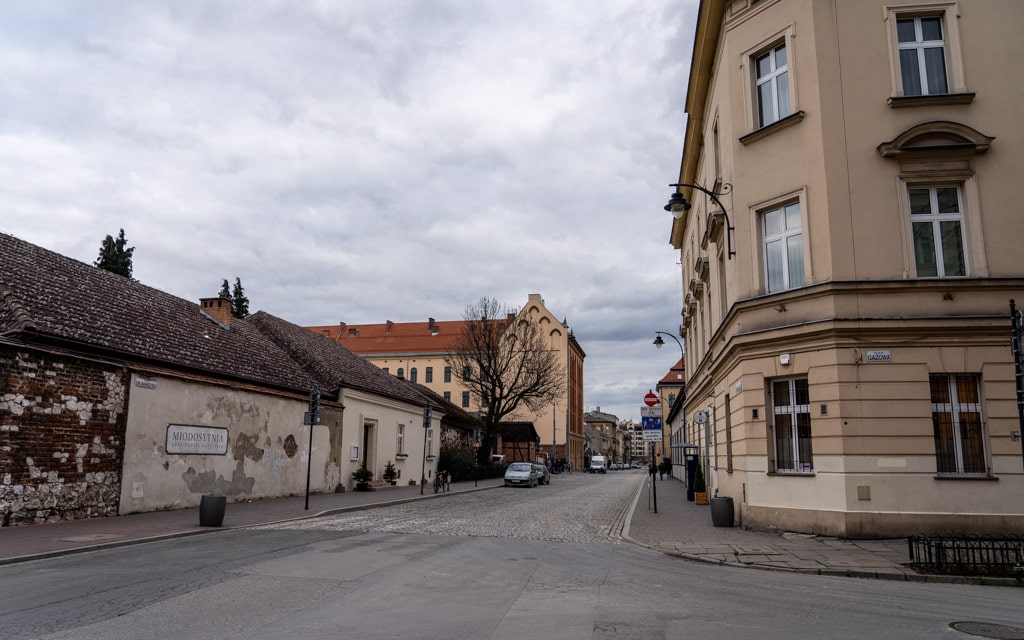
By the 19th century, Kazimierz was not only a Jewish quarter but an important center for local industry. Ulica św. Wawrzyńca (Saint Lawrence Street) was central to Kraków’s industry. Located here were many power and gas plants. Continue down the street.
A little more than a block down on your right-hand side, with tram tracks leading into its courtyard, is the Museum of Municipal Engineering (Muzeum Inżynierii Miejskiej).
This charming, family-friendly museum features antique trams and exhibits describing Kraków’s public transportation history. This was the location of Kazimierz’s old tram depot in the 19th century.
The other half of the old tram depot is across the street. This building now houses Stara Zajezdnia, a restaurant, beer hall, and brewery. The beer garden here is an excellent place for a cold beer in the summer.
Walking another block ahead will bring you to the Judah Square Food Truck Park.
16 – Judah Square Food Truck Park
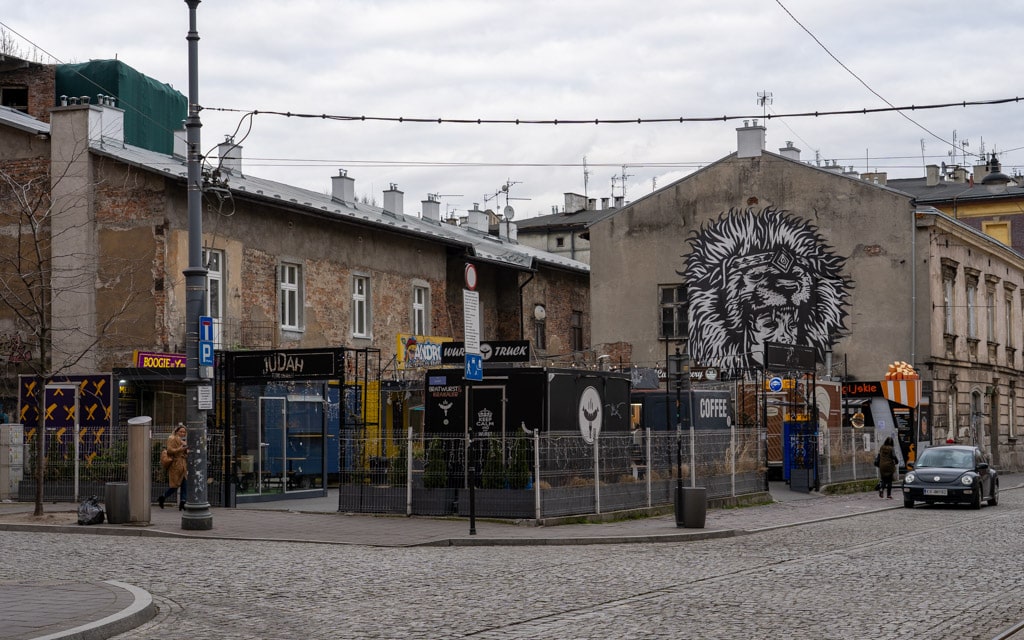
Food trucks seem all the rage these days, which is no different in Kazimierz.
This small collection of food trucks and stalls is the Judah Square Food Truck Park (Skwer Judah) or Judah Food Market. It is one of three food truck lots in Kazimierz.
You are in the right place if you are looking for trendy, affordable street food with a Polish twist. Options include Belgian-style fries (frytki belgijskie), burgers, paninis, grilled sausages, crepes, baked potatoes, chimney cakes, pork sandwiches, and coffee.
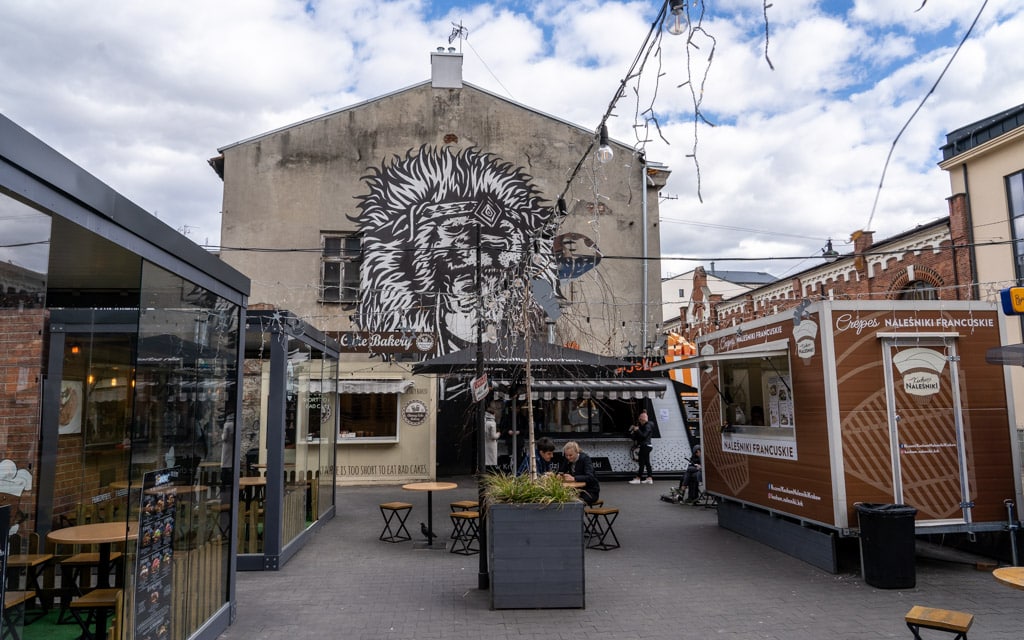
The square is named after the large black and white mural watching over. This graffiti mural, created for the 2013 Jewish Cultural Festival by Israeli street artist Pilpeled, depicts a scared young boy with a lion head. The child represents fear and vulnerability, while the lion represents the Jewish struggle and strength to overcome fear.
I recommend stopping by the yellow Andrus Food Truck, which serves maczanka po krakowsku, a Polish twist on a pulled pork sandwich. All the sandwiches served at Andrus Food Truck are unique. On my visit, I tried the Horseradish (20zł or about $5.01).
This sandwich came with tender pulled pork, village pickles, horseradish sauce, grilled bacon, mustard-pickled sauce, and stewed onions piled on a soft bun. Delicious, filling, and cheap.
17 – Galicia Jewish Museum (Żydowskie Muzeum Galicja)
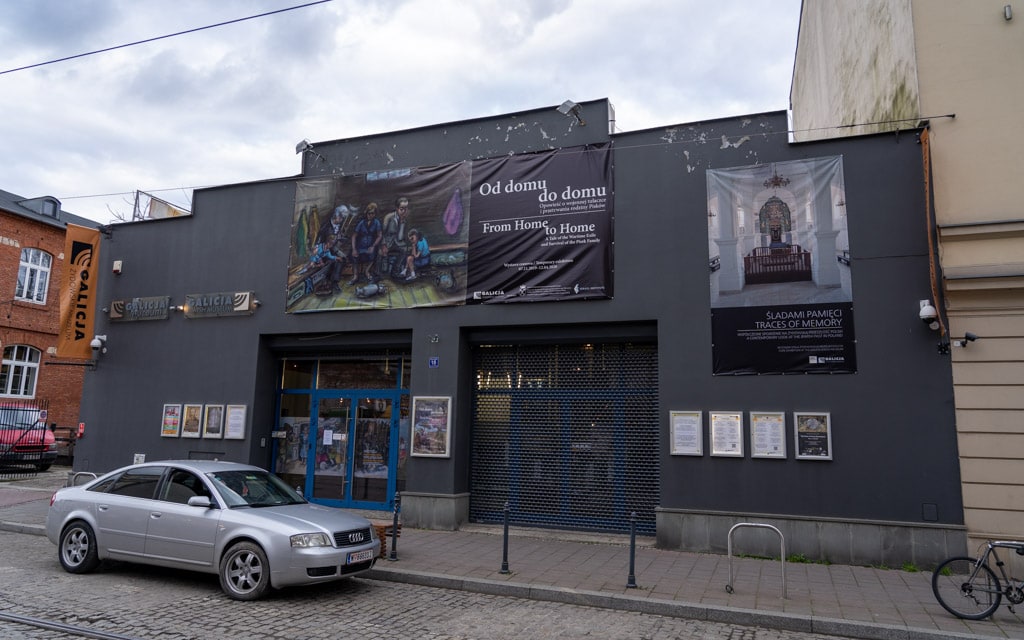
The Galicia Jewish Museum (Żydowskie Muzeum Galicja), which opened in 2004, was founded to remember the victims of the Holocaust while commemorating the culture and life of Polish Galicia.
Galicia is a historical region in present-day southern Poland and western Ukraine.
The highlight of the Galicia Jewish Museum is its permanent photographic exhibit, Traces of Memory.
This unique exhibit displays contemporary photographs of dilapidated synagogues, neglected cemeteries, and other traces of the Jewish past, visible today in small villages and towns scattered around southern Poland. It’s a sad reminder of Jewish life in southern Poland and western Ukraine.
Conclusion
This ends our tour around Kazimierz, Kraków’s historical Jewish district.
From here, you can return to any of the sights listed above or stop by one of the many restaurants and bars in the area for a drink or meal.
With so many things to do in Kazimierz, I recommend staying longer to explore the area at your own pace.
Last Updated on March 30, 2024
